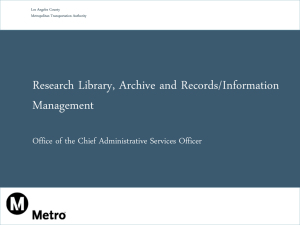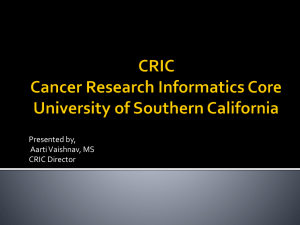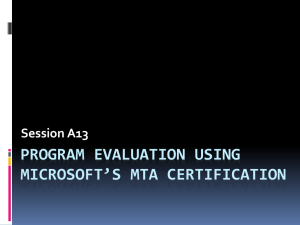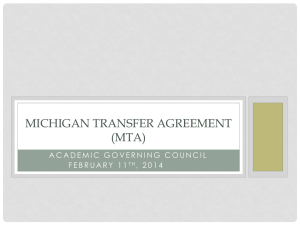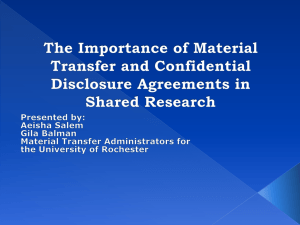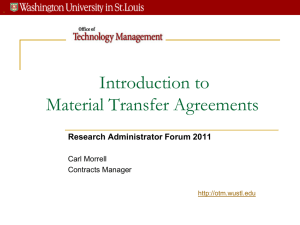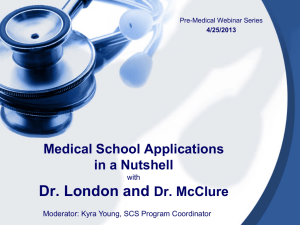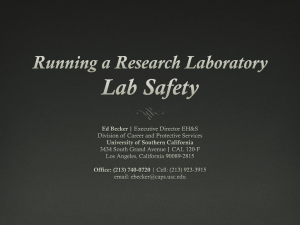HIPAA Privacy Rule at USC - OPRS Office for the Protection of
advertisement
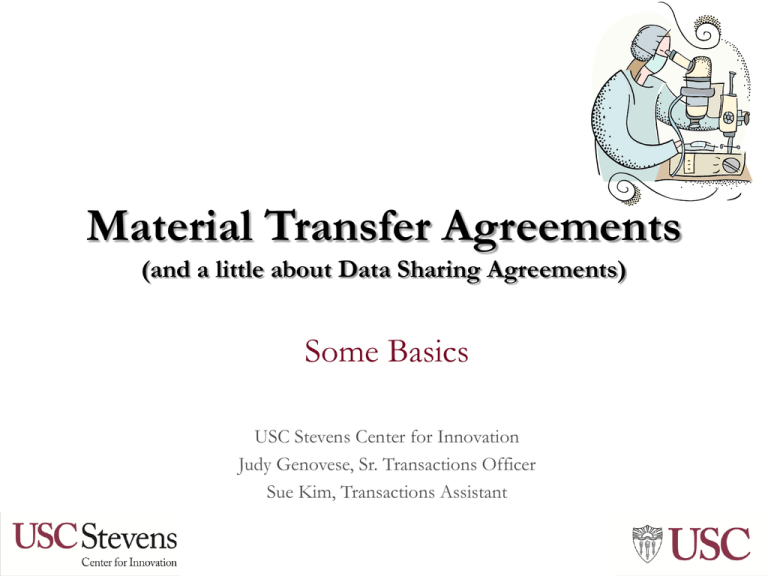
Material Transfer Agreements (and a little about Data Sharing Agreements) Some Basics USC Stevens Center for Innovation Judy Genovese, Sr. Transactions Officer Sue Kim, Transactions Assistant Agenda • What is an MTA? • Why is an MTA important? • Who are the Parties? • Some critical terms in an MTA • What is being transferred? • USC’s process • Our Forms • Data Use Agreements • Questions What is an MTA? • A Material Transfer Agreement (MTA) is a contract between the USC and a third party. • An MTA outlines the rights and responsibilities of the parties that arise due to the transfer and use of the materials. • Provider Recipient What is an MTA? Cont’d… – An MTA is used for the transfer of material that will be used for basic research purposes only; normally no clinical uses are permitted – An MTA should not have a transfer of funds. Why is the MTA important? • The MTA can affect ownership of the PI’s research results and his/her ability to publish • MTAs can protect proprietary material. • Informs Recipient when Material being transferred may be infectious or hazardous. • Can resolves issues: liability, academic credit, loss of control of the material, disagreements. Why is the MTA important? Cont’d… • Without an MTA, the recipient of the material has free rein over use and further distribution of the materials. The provider is giving away the materials if an MTA is not in place. • For transfer of human samples, an MTA is required to ensure compliance with law. Who are the Parties? • University of Southern California – University policy dictates that research agreements must be signed by an authorized university representative – Researchers/faculty are not parties • Third Party– Industry – Government or other Non-profit – Academic • Two USC Faculty Types • University to University – Uniform Biological Material Transfer Agreement (UBMTA) can be used. • • • • • University to Industry Industry to University Non-Profit/Government to University University to Non-Profit/Government Intra-University Some Critical Terms in MTAs • • • • • • • • Definitions Scope of research work Research purposes only (non-commercial) No in-vivo testing Compliance with Federal rules and regulations Confidentiality Re-distribution of material Disclaimers & warranties Some Critical Terms cont’d • No grant of license • Acknowledgment in publications, possible coauthorship • Ownership of Results – “Results”: • Encompasses a fairly broad range of items –IP, discoveries, public disclosures, data What is being transferred? • Biological materials – E.g. cell lines, mice, tissue samples, DNA, etc. – Note: Generally, Material includes Progeny and Unmodified Derivatives, but does not include Modifications • Chemical materials – E.g. Salts, analogs, formulations, compounds, etc. • Prototypes • ???Software??? Inbound vs. Outbound Inbound Material Outbound Material • • • • • A USC PI is receiving material from another party. Other party provides their MTA template for our review. Our PI is restricted to the terms of the MTA in order to protect other party’s interests. PI must have applicable approvals in place before using material (IRB, IBC, IACUC) • • • • • A USC PI is providing material to another party. We provide our MTA template for the other party’s review. We want to protect potentially proprietary and valuable IP. We want to protect university and PI interests. We must be sure we have the right to provide the material. PI must have applicable approvals in place before sending material (IRB, IBC, IACUC, shipping training) Example (inbound material) • Dr. Cardinal, A USC Principal Investigator (PI), is studying effects of alcohol on the liver. •He reads in a publication that Dr. Blue, his colleague at UCLA has created a unique mouse strain that could aid in his research. Example, cont’d… • Dr. Cardinal emails Dr. Blue and asks for a breeding pair of these new unique mice. • Dr. Blue, wanting to protect his new invention, responds, “Why certainly! Please sign this MTA first.” Example, cont’d… • Dr. Cardinal, knowing the drill on MTAs, forwards the agreement to us at USC Stevens Center for Innovation so we can review and sign the MTA on behalf of the USC. • We will notify the PI if there are non-standard terms in the MTA. USC’s Process •The completed MTA form and any questions can be sent to mta@stevens.usc.edu Data Sharing Agreements • A Data Sharing Agreement* (DA) handled by USC Stevens Center is a contract covering the transfer of non-public or restricted data to or from a nonprofit, government or private industry for research use. * Data Agreements often have other names, including Data Use Agreements, Letters or Memoranda of Understanding, Data Consortium Agreements, etc. Data Sharing Agreements • For researchers at USC the same process is followed for DAs as MTAs • Exception – when information subject to HIPAA or privacy laws is involved. – Review by USC’s Office of Compliance in addition to the other MTA steps. – USC Stevens handles obtaining Compliance review Data Sharing Agreements • Identifiable Health Information questions/categories are listed in the MTA Intake forms (See Appendix, #24 on incoming form and #19 on outgoing form) • USC Stevens Center is working with compliance to expand the list to be sure it includes all Identifiable Health Information and non-health privacy related information • NOTE: Identifiable Health Information can sometimes be provided (intentionally or not) with material transferred under an MTA. Care and attention should be used to identify and deal with any such information as in any other circumstance. The “Limited Data Set” from the HIPAA Privacy Rule • Not to be confused with Data Agreements as negotiated by USC Stevens Center /Compliance Office • Covered entities may use or disclose health information that is de-identified without restriction under the Privacy Rule. Covered entities seeking to release this health information must determine that the information has been de-identified using either statistical verification of de-identification or by removing certain pieces of information from each record as specified in the Rule. The “Limited Data Set” from the HIPAA Privacy Rule • A covered entity may de-identify data by removing all 18 elements that could be used to identify the individual or the individual's relatives, employers, or household members; these elements are enumerated in the Privacy Rule. • The covered entity also must have no actual knowledge that the remaining information could be used alone or in combination with other information to identify the individual who is the subject of the information. The “Limited Data Set” from the HIPAA Privacy Rule • Under the de-identification method, the identifiers that must be removed are the following: – Names. – All geographic subdivisions smaller than a state, including street address, city, county, precinct, ZIP Code, and their equivalent geographical codes, except for the initial three digits of a ZIP Code if, according to the current publicly available data from the Bureau of the Census: • The geographic unit formed by combining all ZIP Codes with the same three initial digits contains more than 20,000 people. • The initial three digits of a ZIP Code for all such geographic units containing 20,000 or fewer people are changed to 000. – All elements of dates (except year) for dates directly related to an individual, including birth date, admission date, discharge date, date of death; and all ages over 89 and all elements of dates (including year) indicative of such age, except that such ages and elements may be aggregated into a single category of age 90 or older. The “Limited Data Set” from the HIPAA Privacy Rule – – – – – – – – – – – Telephone numbers. Facsimile numbers. Electronic mail addresses. Social security numbers. Medical record numbers. Health plan beneficiary numbers. Account numbers. Certificate/license numbers. Vehicle identifiers and serial numbers, including license plate numbers. Device identifiers and serial numbers. Web universal resource locators (URLs). The “Limited Data Set” from the HIPAA Privacy Rule – – – – Internet protocol (IP) address numbers. Biometric identifiers, including fingerprints and voiceprints. Full-face photographic images and any comparable images. Any other unique identifying number, characteristic, or code, unless otherwise permitted by the Privacy Rule for re-identification. Questions? • Judy Genovese – jgenoves@stevens.usc.edu • Sue Kim – suekkim@stevens.usc.edu • MTA email address: – mta@stevens.usc.edu • MTA website – http://stevens.usc.edu/mta.php Appendix Appendix cont’d Appendix cont’d • UBMTA – http://www.autm.net/AM/Template.cfm?Section= Technology_Transfer_Resources&Template=/CM/ ContentDisplay.cfm&ContentID=2810 • UBMTA Signatories – http://www.autm.net/AM/Template.cfm?Section= Technology_Transfer_Resources&Template=/CM/ ContentDisplay.cfm&ContentID=8374

